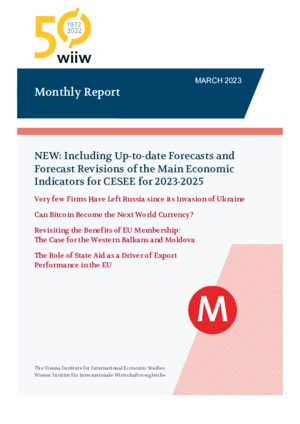Monthly Report No. 3/2023
Vasily Astrov, Chiara Castelli, Javier Flórez Mendoza, Oliver Reiter and Shahab Sharfaei
wiiw Monthly Report No. 3, March 2023
33 pages including 7 Tables and 5 Figures
NEW: Including Up-to-date Forecasts and Forecast Revisions of the Main Economic Indicators for CESEE for 2023-2025
- Chart of the Month: Very few firms have left Russia since its invasion of Ukraine
by Vasily Astrov
- Opinion Corner: Can Bitcoin become the next world currency?
by Shahab Sharfaei
A decade and a half has passed since Bitcoin burst onto the scene. The hopes of the early adopters were that it would be the next world currency – a hope that remains unfulfilled. Fifteen years and a host of scandals and financial bubbles later, the question remains: can Bitcoin deliver on its initial promise?
- Revisiting the benefits of EU membership: the case for the Western Balkans and Moldova
by Javier Flórez Mendoza and Oliver Reiter
Here we re-evaluate the possible economic effects that would arise from the Western Balkan countries plus Moldova joining the EU. Applying a standard model for trade policy analysis, we find increases in real GDP ranging from 0.2% (for Montenegro) to 1.3% (for North Macedonia). Estimated positive changes in exports range from 13% (for Albania) to 18% (for Montenegro). The EU countries would also see positive effects, though of a much smaller magnitude.
- The role of state aid as a driver of export performance in the EU
by Chiara Castelli
In response to the crises of 2007 and 2010, state aid to businesses in the EU was increased substantially, with an average of 16% of it directed towards R&D and innovation. We find evidence of public intervention having had a significant influence in promoting digital competitiveness, especially in terms of digital capital exports and particularly for relatively R&D-intensive industries. Our analysis shows that public intervention should favour a broader approach to supporting digital exports, as more specific state aid that targets R&D and innovation requires prior technological knowledge, if it is to be successful.
Forecasts of main economic indicators for Central, East and Southeast Europe for 2023-2025
From now on, instead of charts with monthly and quarterly statistics, every second month we aim to publish up-to-date forecasts and forecast revisions of the main economic indicators for CESEE countries: real GDP growth, consumer price index (CPI), unemployment rate, current account and fiscal balance. In addition to the existing January and July forecast updates, the additional new updates are scheduled for the March, May, October and December Monthly Report issues.
Reference to wiiw databases: wiiw Annual Database, wiiw Monthly Database
Keywords: war in Ukraine, foreign ownership, Bitcoin, cryptocurrencies, fiat currency, EU accession, GEPPML modelling, state aid, export performance, R&D and innovation, digital exports
Countries covered: EU Member States, Moldova, non specific, Russia, Western Balkans
Research Areas: Macroeconomic Analysis and Policy, International Trade, Competitiveness and FDI
